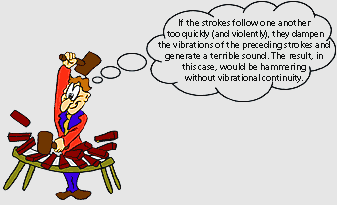|
MUSICAL INTERPRETATION |

|
Staccato is indicated in the score by dots above the notes. These dots, as you know, shorten the length of the sound with rests or breathings.
The various nuances are indicated by a round dot (which reduces the value of the note under it by half); by an elongated dot (which reduces the note by three-quarters - indicating an even sharper staccato); and by a round dot under the slur mark (indicating staccato legato, and reducing the note's value by only a quarter). The so-called portamento ligature, or slur, on the other hand, is placed above two or more notes to indicate a glide (meaning the notes are played grouped together melodically and rhythmically). Obviously, all these nuances can be obtained not just by changing mallets - which is still important - but by adopting the most appropriate technique according to the situation. This technique uses both the sound made through percussion and the appoggiatura through pressure (with the mallet remaining longer on the note struck). So you can go from the short, sharp stroke, obtained by suddenly contracting the fingers and immediately releasing them, to the press stroke, or to the stroke obtained by letting the mallet fall naturally, for legato. The movements vary according to the type of effect desired: short and delicate for a light staccato, quick and decisive for a more marked staccato, rich and resounding, or long and continuous for legato. Staccato may be produced by fingers alone, by the wrist and, in part, also by the forearm. For single notes, the fingers are generally sufficient, while for double notes and chords you also need to articulate your wrist and give a little jerk of the forearm. In the various types of staccato, the quality of results depends on how rapidly you can return to natural playing style after the momentary articulatory contraction needed for staccato playing, whilst for good legato results it is absolutely essential to maintain complete wrist relaxation. The capacity to keep the wrists supple - remember, it is through the wrists that the tendons controllling the fingers pass -allows you to make the "expressive articulation" movements on which legato sounds rely. Of course, all this is much easier on the vibraphone, where you can count on help from the pedal for longer sounds; however, with patience and practice, good results can be obtained on the marimba too. For expressive legato it is also necessary to understand what the correct distance is between the mallets and the keys, and to remember that this distance can vary according to how vigorous playing style is to be. Starting off too high means braking before impact, while too low an initial position limits the space for sufficient swing. For a soft legato cantabile, for example, you need only raise the mallets a few centimetres and touch the keys without any rest or breathing between one sound and another. In practice, it is a case of creating a sound bridge between one note and another, prolonging it after percussion until, and almost beyond, the next note. So much for theoretical technique - difficult to describe at the best of times in subjects of such detail and fine distinction. In practice - which is what counts most - you have to be prepared to learn all you have to know in the time that it takes, which is rather a long time, trying and trying again until you get it right, leaving nothing to chance. When you are trying out various playing styles and techniques, concentrate on perfecting only one movement at a time. For example, we know that for a light staccato the most important thing is to achieve a momentary contraction of the fingers. Let's try and concentrate on the first bar of exercise n° 1, trying to get the exact finger movements to control each of the four sticks. If the ensuing result seems ok to us, then we only have to fix the precise technique in our minds in such a way that we can repeat it with ease in the bars that follow. |